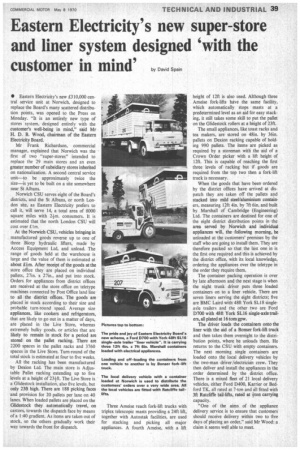Eastern Electricity's new super-store and liner system designed 'with the
Page 41

If you've noticed an error in this article please click here to report it so we can fix it.
customer in mind' by David Spain
• Eastern Electricity's new £310,000 central service unit at Norwich, designed to replace the Board's many scattered distribu tion points, was opened to the Press on Monday. "It is an entirely new type of stores system. designed entirely with the customer's well-being in mind," said Mr H. D. B. Wood, chairman of the Eastern Electricity Board.
Mr Frank Richardson, commercial manager, explained that Norwich was the first of two "super-stores" intended to replace the 29 main stores and an even greater number of subsidiary stores inherited on nationalization. A second central service unit—to be approximately twice the size—is yet to be built on a site somewhere near St Albans.
Norwich CSU serves eight of the Board's districts, and the St Albans, or north Lon don site, as Eastern Electricity prefers to call it, will serve 14, a total area of 8000 square miles with 21m. consumers. It is estimated that the north London CSU will cost over £ I m.
At the Norwich CSU, vehicles bringing in manufactured goods reverse up to one of three Bicep hydraulic lifters, made by Access Equipment Ltd, and unload. The range of goods held at the warehouse is large and the value of them is estimated at about £4-m. After receipt of the goods at the store office they are placed on individual pallets, 27in. x 27in., and put into stock.
Orders for appliances from district offices are received at the store office on teletype machines connected by Post Office land line to all the district offices. The goods are placed in stock according to their size and probable turn-round speed. Average size appliances, like cookers and refrigerators, that are likely to go out in a matter of days, are placed in the Live Store, whereas extremely bulky goods, or articles that are likely to remain in stock for a period are stored on the pallet racking. There are 2200 spaces in the pallet racks and 3760 spaces in the Live Store. Turn-round of the total stock is estimated at four to five weeks.
All the racking has been manufactured by Dexion Ltd. The main store is Adjus table Pallet racking extending up to five levels at a height of 234-ft. The Live Store is a Glidestock installation, also five levels, but only 23ft high. There are 188 picking faces and provision for 20 pallets per lane on 40 lanes. When loaded pallets are placed on the Glidestock they automatically travel, on castors, towards the dispatch face by means of a 1:40 gradient. As items are taken out of stock, so the others gradually work their way towards the front for dispatch. Three Ameise reach fork-lift trucks with triplex telescopic masts providing a 24ft lift, together with Autostak facilities, are used for stacking and picking all major appliances. A fourth Ameise, with a lift height of 12ft is also used. Although three Ameise fork-lifts have the same facility, which automatically stops masts at a predetermined level as an aid for easy stacking, it still takes some skill to put the pallet on the Glidestock rollers at a height of 23ft.
The small appliances, like toast racks and tea makers, are stored on 48in. by 36in. pallets on Dexion racking capable of holding 990 pallets. The items are picked as required by a storeman with the aid of a Crown Order picker with a lift height of 12ft. This is capable of reaching the first three levels of racking but if goods are required from the top two then a fork-lift truck is necessary.
When the goods that have been ordered by the district offices have arrived at dispatch they are taken off the pallets and stacked into mild steel/aluminium containers, measuring I 2ft 4in. by 7ft 6in. and built by Marshall of Cambridge (Engineering) Ltd. The containers are destined for one of the eight district distribution points in the area served by Norwich and individual appliances will, the following morning, be unloaded at the customers' premises by the staff who are going to install them. They are therefore packed so that the hist one in is the first one required and this is achieved by the district office, with its local knowledge, ordering the appliances over the teletype in the order they require them.
The container packing operation is over by late afternoon and the next stage is when the night trunk driver puts three loaded containers on to a liner vehicle. There are seven liners serving the eight districts; five are BMC Laird with 48ft York SL18 singleaxle trailers and the other two are Ford D700 with 48ft York SL16 single-axle trailers, all plated at 16 tons gpw.
The driver loads the containers onto the liner with the aid of a Bonser fork-lift truck and then takes them overnight to the distribution points, where he unloads them. He returns to the CSU with empty containers. The next morning single containers are loaded onto the local delivery vehicles by the two-man driver /electrician crew. They then deliver and install the appliances in the order determined by the district office. There is a mixed fleet of 21 local delivery vehicles, either Ford D400, Karrier or Bedford TK. all rated at 7-ton and all fitted with 3ft Ratcliffe tail-lifts, rated at 4-ton carrying capacity.
"One of the aims of the appliance delivery service is to ensure that customers should receive delivery within two to five days of placing an order," said Mr Wood: a claim it seems well able to meet.
















































































































